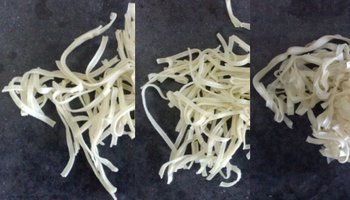VOLUME 7 NUMBER 2 (July to December 2014)

Philipp. Sci. Lett. 2014 7 (2) 413-419
available online: December 15, 2014
*Corresponding author
Email Address: fpflores@up.edu.ph
Submitted: July 29, 2014
Revised: November 24, 2014
Accepted: November 26, 2014
ARTICLE
Characterization of alkaline-cooked quality protein maize as raw material for noodle processing
by Marie Anna Dominique R. Bibat, Olivia M. del Rosario, Lotis E. Mopera, Lilia S. Collado, and Floirendo P. Flores*
Institute of Food Science and Technology, University of the Philippines Los Baños, College, Laguna 4031 Philippines
Quality protein maize (QPM) possesses high tryptophan and lysine contents and may be processed into food products with improved protein content. Alkaline cooking enhances the functional and nutritional properties of corn and can be employed as an intermediate step in processing corn products. In this study, we aimed to evaluate the textural, sensorial, and cooking characteristics of noodles prepared from two white QPM varieties (SWQ 11 and SWQ 15) with different kernel characteristics. The QPM varieties had different starch, protein, fiber, and fat contents. The QPM varieties were nixtamalized and the resulting masa was used for noodle production. The QPM noodles had lower cooking yields (2.5%) than yellow alkaline noodles (YAN) from wheat (3.8%) and corn starch noodles (CSN) (5%). Cooking loss of the SWQ 11 noodles (3.9 %) was lower than SWQ 15 noodles (6.8 %) and YAN (6.9 %). CSN had the greatest cooking loss (15%). Among texture parameters, hardness and cutting stress values of the QPM noodles (7 kgf and 0.6-1.4 kgf, respectively), but gumminess and cohesiveness values were equivalent. Sensory characteristics showed that the QPM noodles had similar flavor absorbance as the control, but YAN and CSN were still preferred. Amylose content significantly influenced the properties of the noodles. The cooking properties of the corn noodles were satisfactory, but the sensory attributes could still be improved. The results of this study can be used to diversify the food use of QPM.
© 2025 SciEnggJ
Philippine-American Academy of Science and Engineering